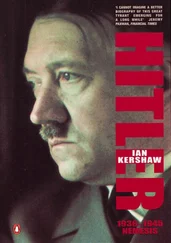31. e.g. BAB, NS6/353, fo. 15, PK Rundschreiben 43/45, 30.1.45; fo. 49, PK Rundschreiben 86/45, 17.2.45; fo. 106, Anordnung 23/45, 21.1.45.
32. BAB, NS6/354, fo. 134, PK Anordnung 48/45g, 1.2.45.
33. BAB, NS6/353, fos. 121–2, PK Anordnung 98/45, 23.2.45.
34. BAB, NS6/353, fos. 65–66 v, PK Rundschreiben 113/45, ‘25. Jahrestag der Verkündung des Parteiprogramms’, 24.2.45.
35. BAB, NS6/353, fos. 157–8, PK Bekanntgabe 28/45, 26.1.45 and Anlage.
36. One of these, Feldjägerkommando II, based behind the lines of Army Group Centre, reported picking up 136,000 soldiers in February, leading to almost 200 facing trial and 46 death sentences. It regarded the ratio of those arrested to the number of troops fighting as unexceptional, given the military situation.— DRZW , 9/1 (Förster), p. 638.
37. Ursula von Kardorff, Berliner Aufzeichnungen 1942–1945 , pb. edn., Munich, 1981, p. 228 (25.1.45).
38. IfZ, Fa-91/5, fo. 1239, Aufruf Himmlers, 31.1.45; BAB, R55/610, fos. 161ff., RPÄ Danzig to State Secretary Dr Naumann, Propaganda Ministry, 31.1.45, attaching Himmler’s proclamation.
39. BAB, NS6/354, fos. 60–61 v, PK Rundschreiben 59/45g, ‘Erfassung von versprengten Wehrmachtangehörigen’, 6.2.45, and attached Anlage reproducing OKW order of 2.2.45. A month later, on 5 March, Field-Marshal Keitel passed on Hitler’s order that all financial support for the families of prisoners entering captivity without being wounded or having demonstrably fought to the last was to be halted.—Printed in Rolf-Dieter Müller and Gerd R. Ueberschär, Kriegsende 1945: Die Zerstörung des Deutschen Reiches , Frankfurt am Main, 1994, p. 163.
40. Andreas Kunz, ‘Die Wehrmacht in der Agonie der nationalsozialistischen Herrschaft 1944/45: Eine Gedankenskizze’, in Jörg Hillmann and John Zimmermann (eds.), Kriegsende 1945 in Deutschland , Munich, 2002, p. 103 n. 26.
41. BAB, NS19/3705, fos. 1–5, Bormann to Himmler, ‘Vorbereitungen für die bevorstehende Feindoffensive im Westen’, and attached Rundschreiben to the western Gauleiter, 8.2.45.
42. BAB, NS6/354, fos. 135–6, PK Anordnung 67/45g, 13.2.45.
43. BAB, NS6/354, fos. 81–4, PK Rundschreiben 92/45g, Rs., 20.2.45.
44. StAM, NSDAP 35, Gauleitung München-Oberbayern, Rundschreiben Nr. 5, 22.2.45.
45. BAB, NS19/2721, fo. 4–4 v, Oberbefehlshaber der Heeresgruppe Weichsel, 12.2.45.
46. TBJG , II/15, p. 459 (9.3.45). Bodies of uniformed German soldiers hanging from a bridge across the Oder near Frankurt in mid-February were said to have led to thousands of ‘stragglers’ reporting for further frontline service.—Wilfred von Oven, Mit Goebbels bis zum Ende , vol. 2, Buenos Aires, 1950, p. 246 (16.2.45).
47. BAB, NS6/756, fos. 2–6, Bormann, ‘Verstärkung der kämpfenden Truppe’, 28.2.45.
48. Norbert Haase, ‘Justizterror in der Wehrmacht’, in Cord Arendes, Edgar Wolfrum and Jörg Zedler (eds.), Terror nach Innen: Verbrechen am Ende des Zweiten Weltkrieges , Göttingen, 2006, pp. 84–5, reckons that half a million German soldiers might have been sentenced by military courts over the duration of the war, implying, therefore, that the numbers down to the end of 1944 doubled in the last four months. There were eighteen times as many death sentences as in the period from June 1941 to November 1944. Fritz Wullner, NS-Militärjustiz und das Elend der Geschichtsschreibung , Baden-Baden, 1991, p. 461, estimates a figure of around 300,000 deserters down to the end of 1944. For the organization of the terror apparatus within the Wehrmacht, including the extended use of the Geheime Feldpolizei , see John Zimmermann, Pflicht zum Untergang: Die deutsche Kriegführung im Westen des Reiches 1944/45 , Paderborn, 2009, pp. 139–65.
49. Benjamin Ziemann, ‘Fluchten aus dem Konsens zum Durchhalten: Ergebnisse, Probleme und Perspektiven der Erforschung soldatischer Verweigerungsformen in der Wehrmacht 1939–1945’, in Rolf-Dieter Müller and Hans-Erich Volkmann (eds.), Die Wehrmacht: Mythos und Realität , Munich, 1999, pp. 594–6, 599; Otto Hennicke, ‘Auszüge aus der Wehrmachtkriminalstatistik’, Zeitschrift für Militärgeschichte , 5 (1966), pp. 442–50; Manfred Messerschmidt and Fritz Wullner, Die Wehrmachtjustiz , Baden-Baden, 1987, p. 91; Richard Bessel, Germany 1945: From War to Peace , London, 2009, p. 63. The figure of 35,000 underestimates the scale of desertion. One estimate places the figure at more than 100,000.—Manfred Messerschmidt, ‘Deserteure im Zweiten Weltkrieg’, in Wolfram Wette (ed.), Deserteure der Wehrmacht , Essen, 1995, p. 62. A further 35,000 were sentenced for other contraventions of military law (Ziemann, p. 604). On the procedures for carrying out the death penalty in the Wehrmacht, see Manfred Messerschmidt, Die Wehrmachtjustiz 1933–1945 , Paderborn, 2005, pp. 393–400.
50. Messerschmidt, ‘Deserteure im Zweiten Weltkrieg’, p. 61; Haase, p. 85 and p. 100 n. 26; DRZW , 9/1 (Echternkamp), p. 50. While the western liberal democracies executed few soldiers, Germany was not alone among authoritarian regimes in its draconian punishment. Japan executed 22,253 soldiers; estimates (though detailed research remains to be carried out) suggest that as many as 150,000 may have been executed in the Soviet Union.—Ulrich Baumann and Markus Koch (eds.), ‘Was damals Recht war…’: Soldaten und Zivilisten vor Gerichten der Wehrmacht , Berlin-Brandenburg, 2008, p. 184.
51. e.g. BAB, R55/620, fo. 132, SD report to State Secretary Dr Naumann, Propaganda Ministry, ‘Stimmung und Haltung der Arbeiterschaft’ (reported opinion among workers in Mecklenburg), 1.3.45.
52. BA/MA, N60/17, NL Schörner, letter from Schörner to Oberst i.G. Thilo von Trotha, Generalstab des Heeres, Chef Operations-Abt., 22.2.45. Partially quoted also in Andreas Kunz, Wehrmacht und Niederlage: Die bewaffnete Macht in der Endphase der nationalsozialistischen Herrschaft 1944 bis 1945 , Munich, 2007, p. 113.
53. BAB, NS6/354, fos. 163–165 v, PK Bekanntgabe 149/45g, 19.3.45, attaching a copy of Schörner’s four-page message dated 27.2.45.
54. BA/MA, N712/15, NL Pollex, Colonel Curt Pollex, Auszüge aus Briefen, fo. 35, 18.2.45.
55. BAB, R55/610, fos. 156–9, correspondence related to propaganda in the Ruhr, 19.12.44–12.1.45.
56. Von Oven, Finale Furioso , p. 584 (22.2.45).
57. See Bormann’s attempt to check the spread of rumour, in BAB, NS6/353, fos. 16–17, ‘Bekämpfung beunruhigender Gerüchte über die Frontlage’, 1.2.45.
58. IfZ, Fa 91/2, fos. 278–81, ‘Vorlage: Sondereinsatz Politischer Leiter an Brennpunkten der Ost- und Westfront’, 17.2.45.
59. BAB, R55/608, fos. 35–6, Chef des Propagandastabes, Mundpropagandaanweisung, betr. Kriegslage, 17.2.45.
60. BHStA, Reichsstatthalter Epp 681/1–8, Reich Minister of the Interior to Reich Defence Commissars, etc., 28.2.45.
61. BA/MA, RH19/IV/228, fo. 10, Hinweis für die NS-Führung der Truppe, 4.2.45.
62. DZW , 6, p. 627, citing a letter to Bormann of Joachim Albrecht Eggeling, Gauleiter of Halle-Merseburg, 10.2.45.
63. BAB, NS6/137, fos. 40–41, Flugblatt (im Entwurf): ‘An die Verteidiger von Berlin’, 24.2.45.
64. Quoted in Steinert, p. 559.
65. TBJG , II/15, p. 352 (10.2.45).
66. BAB, NS6/354, fos. 137–138 v, PK Anordnung 79/45g, Standgerichte, 15.2.45, and ‘Verordnung über die Errichtung von Standgerichten vom 15. February 1945’, Reichsgesetzblatt , Teil 1, Nr. 6, 20.2.45, p. 30; printed in Müller and Ueberschär, pp. 161–2.
67. BAB, NS19/3705, fo. 4, Vorbereitungen auf Feindoffensive im Westen, Fernschreiben from Bormann to the western Gauleiter, undated appendix to his letter to Himmler, 8.2.45.
Читать дальше












